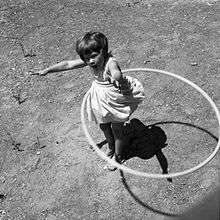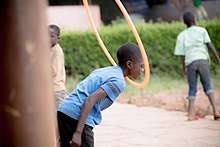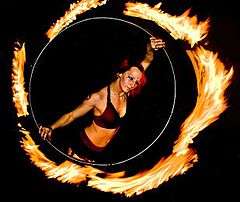Hula hoop
A hula hoop is a toy hoop that is twirled around the waist, limbs or neck. The modern hula hoop was invented in 1958 by Arthur K. "Spud" Melin and Richard Knerr, but children and adults around the world have played with hoops throughout history. Hula hoops for children generally measure approximately 70 centimetres (28 in) in diameter, while those for adults measure around 1 metre (40 in). Traditional materials for hoops include willow, rattan (a flexible and strong vine), grapevines and stiff grasses. Today, they are usually made of plastic tubing.[1]


Origins
Native American Hoop Dance is a form of storytelling dance incorporating hoops as props. These props are used to create both static and dynamic shapes, which represent various animals, symbols, and storytelling elements. The dance is generally performed by a solo dancer with multiple hoops.
Before it was known and recognized as the common colorful plastic toy (sometimes filled with water or sand), the traditional "hula hoop" was made of dried willow, rattan, grapevines, or stiff grasses. Though they have been in existence for thousands of years, it is often incorrectly believed that they were invented in the 1950s.[2]
Author Charles Panati records a "craze" with the usage of wooden and metal hoops in 14th-century England. He reports that doctors treated patients suffering from pain, dislocated backs, and even heart failure due to hooping.[3] Panati also says that the name "hula" came from the Hawaiian dance in the 18th century, due to the similar hip movements.[3]
Modern history
The hula hoop gained international popularity in the late 1950s, when a plastic version was successfully marketed by California's Wham-O toy company. In 1957 Joan Anderson brought back a bamboo "exercise hoop" from Australia, and came up with the name Hula Hoop at a dinner party. Her husband showed it to Arthur "Spud" Melin and they agreed on a gentleman's handshake that they would have a share of any profits (the company cut her out, and they got nothing).[4][5]
Richard Knerr and Arthur "Spud" Melin, manufactured 1.06-metre (42 in) hoops with Marlex plastic. With giveaways, national marketing and retailing, a fad begin in July 1958:[6][7] twenty-five million plastic hoops were sold in less than four months, and sales reached more than 100 million units in two years.[1] Carlon Products Corporation was one of the first manufacturers of the hula hoop; during the 1950s, Carlon was producing more than 50,000 hula hoops per day. The hoop was inducted into the National Toy Hall of Fame at The Strong in Rochester, New York, in 1999.
The hula hoop craze swept the world, dying out again in the 1980s, but not in China and Russia, where hula hooping and hoop manipulation were adopted by traditional circuses and rhythmic gymnasts.
Hooping as an activity

Many modern hoopers make their own hoops out of PVC piping, or polypropylene tubing (known as polypro). The polyethylene hoops, and especially the polyvinyl chloride hoops, are much larger and heavier than hoops of the 1950s. The size and the weight of the hoop affect the style of the hooper. Heavier, larger hoops are more often used for beginner dancers and easier tricks, while lighter, thinner tubing is used for quick hand tricks. These hoops may be covered in a fabric or plastic tape to create more of a visual image and distinguish between the hoop and dancer. Gaffer Tape is also used to line the inside of a hula hoop to add grip or when using a bare hula hoop it can be roughened by using sandpaper. Some use glow-in-the dark, patterned, or sparkling tape, and others are produced with clear tubing and are never filled with materials (usually hoops for children are filled with an array of materials). LED technology has also been introduced in the past few years, allowing hoops to light up at the flick of a switch or a remote control. Programmable 'Smart Hoops' are available which provide a range of special effects and some can even be customized through an application on a mobile device.
Modern hooping has created a wide range of tricks. Hooping now includes many 'on body' moves and many 'off body' moves. A few examples include breaks, isolations, leg hooping, and double hooping.
Hooping has now become a popular fitness activity, with classes in many cities across the world.[8]
A recent development in hooping has been fire hooping, in which spokes are set into the outside of the hoop and tipped with kevlar wicks, which are soaked in fuel and lit on fire.
Some companies produce collapsible hula hoops for easy transport and versatility.
World records
Duration
The longest verified record for continuous hula hoop spinning is held by Aaron Hibbs from Columbus, Ohio who kept a hoop spinning for 74 hours and 54 minutes between October 22, through 25, 2009.[9]In November 2019, Jenny Doan exceeded this record by hula-hooping for 100 hours at the District Brew Yards in Chicago. She has submitted her results to the Guinness World Records and is waiting for confirmation of her inclusion.[10]
Most hula hoops twirled at once
The record for most hula hoops twirled at the same time is 200, by Marawa The Amazing.[11]
Hula hoop dancing
On 19 February 2013, 4,483 people swung hula hoops to dance music for seven minutes. They did this without interruption at Thammasat University stadium in Thailand, setting a world record for the most people dancing with hula hoops simultaneously in one place.
Other records
The largest hoop successfully twirled was 5.04 m (16.5 ft) in diameter, by Ashrita Furman of the United States in September, 2010.[12]
In 2000, Roman Schedler spun a 53-pound tractor tyre for 71 seconds at the 5th Saxonia Record Festival in Bregenz, Austria.[13]
In April 2010, 70 hoopers on Team Hooprama hula hooped the Music City Half-Marathon (21.0975 kilometres (13.1094 mi)) to raise awareness and funds for Hooping for Hope.[14][15]
In March 2013, the largest hula hoop workout (407 participants) was achieved at Ravenscraig Regional Sports Facility in Scotland by North Lanarkshire Leisure and Powerhoop Fitness.[16]
In popular culture
- On September 6, 1958, singer Georgia Gibbs appeared on US TV's The Ed Sullivan Show to sing "The Hula Hoop Song". Her last (US top-40) hit, it competed with four other songs created in the wake of the huge fad.[17]
- Hula hoops are referred to in the 1958 Alvin and the Chipmunks song, "The Chipmunk Song (Christmas Don't Be Late)". Wayout Toys, under license to Emson, introduced the Alvin Hula Hoop Doll, which dances with his hula hoop and sings the song based on wanting his hula hoop.
- Joel and Ethan Coen's 1994 comedy film The Hudsucker Proxy tells a fictional story of the hula hoop's invention by a mail room clerk (Tim Robbins) who is installed as president of a manufacturing company as part of an intended business scheme.
- Around the time when the Pixar Animation Studios film WALL-E was in production, Disney.com released a clip of Wall-E's first encounter with a hula hoop, swinging it across its neck.
- Artist Keller Williams released a song "Hula Hoop to the Loop", dedicated to the toy.
- The final season of M*A*S*H contains an episode titled "Who Knew?", in which Sergeant Klinger sees kids playing with barrel rings, and fashions a hula hoop-like toy made of metal tubing. He then tries to get Major Winchester to fund their production, but is unable to.
References
- "Background, history, raw materials, design, and the manufacturing process of hula hoops". Madehow.com. Retrieved 2011-05-23.
- "Hula Hoop History". The Great Idea Finder. Retrieved 22 June 2012.
- Panati, Charles (1989). The Extraordinary Origins of Everyday Things. William Morrow Paperbacks / HarperCollins. ISBN 0062277081.
- Chris Riess; Amy Hill (March 25, 2019). "She Was Betrayed by a Gentleman's Handshake". The Atlantic.
- Hula Girl.
- Brymer, Chuck (2008). The nature of marketing: marketing to the swarm as well as the herd. Palgrave Macmillan. p. 22.
- Olson, James Stuart (2000). Historical dictionary of the 1950s. Greenwood Publishing Group. p. 136.
- Infinite Circles. "Beginners guide to learning hula hooping".
- Guinness World Records. "Longest marathon hula hooping". guinnessworldrecords.com. Retrieved 2013-03-02.
- Johnson, Lauren M. "Hips don't lie: There is a new marathon hula-hooping record holder". CNN. Retrieved 2019-11-24.
- Howard, Jane (21 February 2019). "Marawa the Amazing: how one woman with 200 hula hoops became a teen girl guru". The Guardian. Retrieved 26 February 2019.
- "Largest Hula Hoop Spun". www.guinnessworldrecords.com. Retrieved 8 March 2015.
- Ralf Laue. "Hula Hoop World Records". Recordholders.org. Retrieved 2011-05-23.
- "Hooping for Hope". Hooping for Hope. Retrieved 2011-05-23.
- "Group Hula Hoops Marathon to Raise Awareness - NewsChannel5.com | Nashville News, Weather & Sports". NewsChannel5.com. 2010-04-23. Retrieved 2011-05-23.
- Guinness World Records. "Largest Hula Hoop Workout".
- Schoemer, Karen (2006). Great Pretenders: My Strange Love Affair with '50s Pop Music. Simon and Schuster. pp. 93–95.
Further reading
- Caughey, T. K. (February 1960), "Hula-Hoop: An Example of Heteroparametric Excitation", American Journal of Physics, 28 (2): 104–109, Bibcode:1960AmJPh..28..104C, doi:10.1119/1.1935069
- Seyranian, Alexander P.; Belyakov, Anton O. (July 2011), "How to twirl a hula hoop", American Journal of Physics, 79 (7): 712–715, arXiv:1101.0072, Bibcode:2011AmJPh..79..712S, doi:10.1119/1.3576177
External links
| Wikimedia Commons has media related to Hula hoops. |